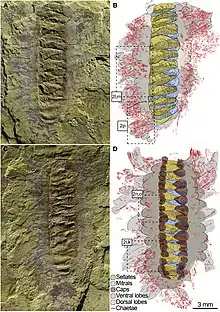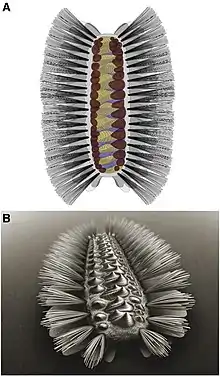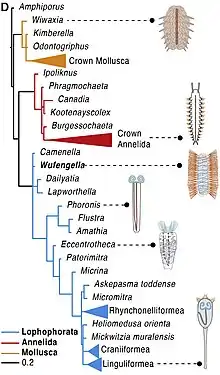Wufengella
Wufengella is a genus of extinct camenellan "tommotiid" that lived during the Early Cambrian (Stage 3). Described in 2022, the only species Wufengella bengtsonii was discovered from the Maotianshan Shales of Chiungchussu (Qiongzhusi) Formation in Yunnan, China.[1] The fossil indicates that the animal was an armoured worm that close to the common ancestry of the phyla Phonorida, Brachiozoa and Bryozoa, which are collectively grouped into a clade called Lophophorata.[2]
| Wufengella Temporal range: | |
|---|---|
 | |
| Scientific classification | |
| Domain: | Eukaryota |
| Kingdom: | Animalia |
| Clade: | Lophophorata |
| Order: | †"Tommotiida" |
| Genus: | †Wufengella Guo et al., 2022 |
| Species: | †W. bengtsoni |
| Binomial name | |
| †Wufengella bengtsoni Guo et al., 2022 | |
Discovery
Wufengella is known from a single specimen. The fossil was discovered by Chinese palaeontologists Jin Guo and Peiyun Cong at the Yunnan University. An almost complete fossil, parts of the anterior end are missing.[1] The location of the specimen, Chiungchussu Formation at Haikou, Kunming, Southwest China, is member of the Chengjian Lagerstätte that is established to belong to Cambrian Stage 3 (between 521 and 514 million year ago).[3][4] The same fossil deposit had yielded worm-like lobopod Facivermis[5] and Cambrian chordate (myllokunmingiid)[6] among other animal fossils.[7][8]
The name Wufengalla is after the Wufeng Hill in Chengjiang. Wufeng is a Chinese word for "dancing/flying phoenix." The species name was given to honour Stefan Bengtson, a palaeontologist at the Swedish Museum of Natural History. The specimen (CJHMD00041) is maintained at the Nature Museum of Yunnan.[1] Luke A. Parry at the University of Oxford identified the specimen as a tommotiid worm, and the description was published in Current Biology.[9]
Description

From a partially incomplete fossil, Wufengella is known to have an elongated body that measures about 16 mm (0.63 in) long.[1] It has long bristles on both sides of the body that are presumed to be sensory organs for detecting their immediate surrounding such as approaching predators. It also has flap-like structures that could be suction organs for attachment to objects. In contrast to its related lophophorates which are fixed to sea floors, Wufengella was likely actively mobile..[10]
The back (dorsal) side of Wufengella is studded with armoured plates called sclerites. The sclerites are arranged almost randomly (bilaterally asymmetrical) throughout the body. However, there is some pattern of organisation. The larger major sclerites are aligned in two rows along the body length, and the tiny minor ones are distributed unevenly in between the two major rows.[9]
Evolutionary importance

Wufengella has two important features that contribute to evolutionary changes in ancient invertebrate group, the lophophorates, that include the tommotiids as one group. One feature is the presence of sclerites, which is a common structure that distinguishes tommotiid species. In all groups, except the tannuolinids (such as Micrina),[11] the sclerites are asymmetrical. The structure and distribution of sclerites indicate the linkage between the different groups.[1]
Another feature is body segmentation. The arrangement of the sclerites and the bristles indicate that the body is transversely segmented as in modern annelid worms. This suggest that Wufengella could be related to the common ancestor of annelids and brachiopods. In addition, the over structure indicates that it could be close to the common ancestry Phonorida, Brachiozoa and Bryozoa.[2] The three phyla are established to constitute the same evolutionary lineage and are collectively grouped into a clade called Lophophorata.[12] It has been predicted that the last common ancestor of the lophophorates would be a sessile, lophophore-bearing suspension feeder having U-shaped gut (called lophophore),[13][14] The fact that Wufengella was mobile implies that it lies outside the crown group of Lophophorata.[1]
References
- Guo, Jin; Parry, Luke A.; Vinther, Jakob; Edgecombe, Gregory D.; Wei, Fan; Zhao, Jun; Zhao, Yang; Béthoux, Olivier; Lei, Xiangtong; Chen, Ailin; Hou, Xianguang; Chen, Taimin; Cong, Peiyun (2022). "A Cambrian tommotiid preserving soft tissues reveals the metameric ancestry of lophophorates". Current Biology. 32 (21): S0960–9822(22)01455–5. doi:10.1016/j.cub.2022.09.011. ISSN 1879-0445. PMID 36170853.
- Gasparini, Allison (2022-10-13). "This ancient worm might be an important evolutionary missing link". ScienceNews. Retrieved 2022-10-14.
- Liu, Yu; Lerosey-Aubril, Rudy; Audo, Denis; Zhai, Dayou; Mai, Huijuan; Ortega-Hernández, Javier (2020). "Occurrence of the eudemersal radiodont Cambroraster in the early Cambrian Chengjiang Lagerstätte and the diversity of hurdiid ecomorphotypes". Geological Magazine. 157 (7): 1200–1206. Bibcode:2020GeoM..157.1200L. doi:10.1017/S0016756820000187. ISSN 0016-7568. S2CID 216195570.
- Guo, Jin; Pates, Stephen; Cong, Peiyun; Daley, Allison C.; Edgecombe, Gregory D.; Chen, Taimin; Hou, Xianguang (2019). "A new radiodont (stem Euarthropoda) frontal appendage with a mosaic of characters from the Cambrian (Series 2 Stage 3) Chengjiang biota". Papers in Palaeontology. 5 (1): 99–110. doi:10.1002/spp2.1231. S2CID 134909330.
- Liu, J.; Han, J.; Simonetta, A. M.; Hu, S.; Zhang, Z.; Yao, Y.; Shu, D. (2006). "New observations of the lobopodian-like worm Facivermis from the Early Cambrian Chengjiang Lagerstätte". Chinese Science Bulletin. 51 (3): 358–363. Bibcode:2006ChSBu..51..358L. doi:10.1007/s11434-006-0358-3. S2CID 84052429.
- Zhao, Jun; Li, Guo-Biao; Selden, Paul A. (2019). "A poorly preserved fish-like animal from the Chengjiang Lagerstätte (Cambrian Series 2, Stage 3)". Palaeogeography, Palaeoclimatology, Palaeoecology. 520: 163–172. Bibcode:2019PPP...520..163Z. doi:10.1016/j.palaeo.2019.02.005. S2CID 134483565.
- Yugan, Jin; Xianguang, Hou; Huayu, Wang (1993). "Lower Cambrian pediculate lingulids from Yunnan, China". Journal of Paleontology. 67 (5): 788–798. doi:10.1017/S0022336000037057. ISSN 0022-3360. S2CID 131913237.
- Yugan, Jin; Huayu, Wang (1992). "Revision of the Lower Cambrian brachiopod Heliomedusa Sun & Hou, 1987". Lethaia. 25 (1): 35–49. doi:10.1111/j.1502-3931.1992.tb01790.x. ISSN 0024-1164.
- "Armoured worm reveals the ancestry of three major animal groups". www.bristol.ac.uk. University of Bristol. 2022-09-27. Retrieved 2022-10-17.
- Pester, Patrick (2022-09-30). "Ancient armored 'worm' is the Cambrian ancestor to three major animal groups". Livescience. Retrieved 2022-10-14.
- Holmer, Lars E.; Skovsted, Christian B.; Brock, Glenn A.; Valentine, James L.; Paterson, John R. (2008). "The Early Cambrian tommotiid Micrina, a sessile bivalved stem group brachiopod". Biology Letters. 4 (6): 724–728. doi:10.1098/rsbl.2008.0277. ISSN 1744-9561. PMC 2614141. PMID 18577500.
- Nesnidal, Maximilian P.; Helmkampf, Martin; Meyer, Achim; Witek, Alexander; Bruchhaus, Iris; Ebersberger, Ingo; Hankeln, Thomas; Lieb, Bernhard; Struck, Torsten H.; Hausdorf, Bernhard (2013-11-17). "New phylogenomic data support the monophyly of Lophophorata and an Ectoproct-Phoronid clade and indicate that Polyzoa and Kryptrochozoa are caused by systematic bias". BMC Evolutionary Biology. 13: 253. doi:10.1186/1471-2148-13-253. ISSN 1471-2148. PMC 4225663. PMID 24238092.
- Vinther, Jakob; Parry, Luke; Briggs, Derek E. G.; Van Roy, Peter (2017-02-23). "Ancestral morphology of crown-group molluscs revealed by a new Ordovician stem aculiferan". Nature. 542 (7642): 471–474. Bibcode:2017Natur.542..471V. doi:10.1038/nature21055. hdl:1983/70368bb0-c2df-490a-8b45-26e7b4397596. ISSN 1476-4687. PMID 28166536. S2CID 205253410.
- Budd, Graham E.; Jackson, Illiam S. C. (2016-01-05). "Ecological innovations in the Cambrian and the origins of the crown group phyla". Philosophical Transactions of the Royal Society of London. Series B, Biological Sciences. 371 (1685): 20150287. doi:10.1098/rstb.2015.0287. ISSN 1471-2970. PMC 4685591. PMID 26598735.